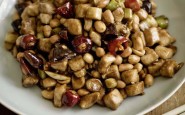Bird’s nest soup
Like Shark’s fin soup, Bird’s nest soup reaches the heights of Chinese cuisine, though Westerners are often put off by the name and the fact that it is produced by swallow’s saliva. On its own, bird’s next is bland, and its function is to provide texture, rather than taste, to the soup. A very rich, prime stock is therefore essential as a base, as is the Chicken velvet. And yet, without the bird’s nest, no amount of prime stock or chicken velvet could produce the unique quality of this soup.
100g (4 oz) loose bird’s nest
4 thickish slices fresh ginger root, peeled
2 large spring onions
1.1-1.4 litres (2-2 1/2 pints) prime stock
30ml (2 tbsp) cornflour, dissolved in 30ml (2 tsbp) water
salt to taste
1/2-1 quantity Chicken velvet
25g (1 oz) best ham, ideally Chinhua, York or Virginia, finely chopped
Method
1. Soak the bird’s nest in about 1.4 litres (2½ pints) tepid water for several hours or overnight. Drain through a fine sieve. It will have increased about 4 times in weight.
2. With a pair of tweezers, remove any feathers or other impurities. Depending on the quality of the bird’s nest, this could be a time-consuming task. Rinse in cold water 2-3 times and drain.
3. Put into a saucepan, add the ginger, spring onions and about 1.4 litres (2½ pints) boiling water. Return to the boil, then simmer for 10 minutes. Remove and discard the ginger and spring onions. Drain but leave damp. (The bird’s nest can now be left in the refrigerator, covered, for 2-3 days before making the soup.)
4. Put the bird’s nest and prime stock into a large saucepan and bring to a gentle simmer. Stir in the dissolved cornflour and let the soup thicken. Add salt to taste, if necessary.
5. Stir about 2 ladles of hot soup into the chicken velvet to make the purée thinner. Stream into the simmering soup, stirring to make a smooth consistency. Continue to simmer until the chicken is cooked.
6. Transfer to a warm soup tureen. Sprinkle the chopped ham on top in the centre. Serve hot.
Any leftover soup can be frozen.
Taken from Yan-kit So’s book “Yan-Kit’s Classic Chinese Cookbook” with permission. © Yan-kit So. Published by Dorling Kindersley. ISBN 0-7513-0563-4.


